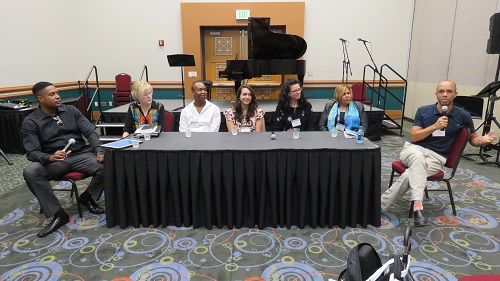The Journey to Inclusion
by Mariana S. Gariazzo
Presented by the NFA Cultural Outreach Committee,* this panel provided a safe space for NFA members to share diverse viewpoints on inclusion. In a dynamic interchange led by moderators, James Miller and Caen Thomason-Redus, panelists and audience members alike were invited to share personal accounts of exclusion and inclusion and to brainstorm strategies for increasing integration and respect for all members of the flute community.
Panelists Catherine Ramirez, Nora Lee Garcia, Eileen Grycky, William Linthicum-Blackhorse, Jeiran Hassan, and Brian Dunbar analyzed issues of diversity and inclusion across all sectors of music making with an emphasis on higher education and the workforce.
A warm and candid atmosphere allowed all participants to discuss issues of representation, disabilities, nationality, gender, race, cultural and religious background as well as insights on fostering meaningful relationships that bridge and embrace our differences.
*Editor's Note: The committee is now called the Diversity and Inclusion Committee
by Kathy Melago
This panel discussion provided a wonderful and needed opportunity and far exceeded my expectations. Moderators Caen Thomas-Redus and James Miller guided the conversation between the audience and panelists Nora Lee Garcia, Catherine Ramirez, Jeiran Hasan, Brian Dunbar, and Eileen Grycky.
I feel compelled to give this chronicle a disclaimer in the chance that any intentions of those at the session are not reflected exactly as they intended here, which is not my intent. This chronicle is written through the lens of my experience at this session and will represent the themes and content to the best of my ability.
The opening question, “How would you discuss diversity and inclusion in the workplace?” started a conversation that involved the experiences of the panelists combined with experiences, reactions, comments, and questions from the audience.
One panelist said, “Diversity is being asked to the party. Inclusion is being asked to dance once you get there.” That is a profound statement in light of well-intentioned attempts at increasing diversity in a world where it is not always readily accepted. How can we encourage our profession to not only move to the point of having more diverse rosters or personnel, but also to ensure that when they arrive, they are included? While we did not solve that issue in the session, the experience provided the audience with more awareness of the issues so we can take action to promote change. We were reminded that we cannot understand the depth of what others are dealing with in terms of being included, no matter how hard we try, but the important thing is to try and to recognize that we cannot fully know.
We discussed the fact that diversity goes beyond how we look and what religious beliefs we may or may not have to include the way we think. Diversity of ideas is also a type of diversity. We also talked about the need to get beyond siloing diversity with concerts for Black History Month or programs of all women composers to integrating the works all the time; siloing works in this way can be undesirable to some because it feels patronizing. Also to avoid: thinking that someone of a certain heritage or from a general region is an expert on them. For example, someone from Venezuela is not going to likely be an expert on all of the musical styles of Latin America.
Advice also targeted organizations, which need to be careful not to exploit diversity. For example, people should be hired because they are excellent at what they do, not to fill a quota to get a grant or to be able to take a photo of the organization and misrepresent what its real approach is regarding diversity. There are often implicit biases that affect how decisions are made around diversity, and often these decisions are about money, not truly wanting to be inclusive. When people in an organization are uncomfortable with diversity, it is uncomfortable for everyone. For example, if an African American flutist wins an orchestral position and everyone ignores the person once there, that person will feel uncomfortable and unwanted. Fitting in and belonging are not the same thing.
For individuals who are minorities, panelists suggested that they share projects that showcase their diversity. For example, if someone is living in one country but came from another and travels back for a vacation, that person should feel proud upon returning to share experiences of her home culture. This can help others develop more of an understanding and appreciation for what is different by getting the chance to experience it through someone they know. Minorities can also be receptive to innocent requests by others to understand their experiences better and help to teach them how to be more inclusive or open-minded.
The conversation in this session could have gone on forever. In closing, the panelists agreed about the importance of voicing these very important issues at the National Flute Association convention. Not all similar organizations have these conversations, and the fact that this one was held this year gives hope for the future of our community.
James Miller and Caen Thomason-Redus moderated the session.

- Convention
- Scholarships & Competitions
- Resources & Publications
- Programs
-
Committees
- About Our Committees
- Committee Webpages
- NFA Committees Blog
- Committee Web Presence Guidelines
- Giving
- About
- Community
- PayPal
- Walfrid Kujala Tributes